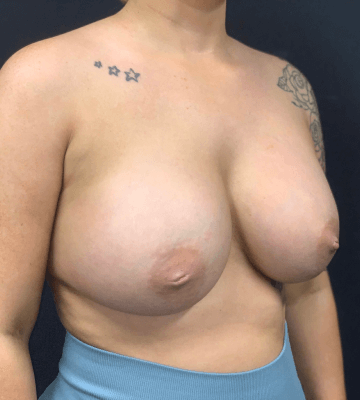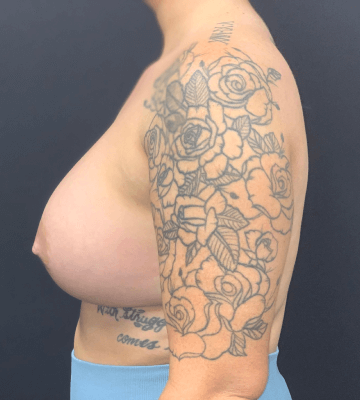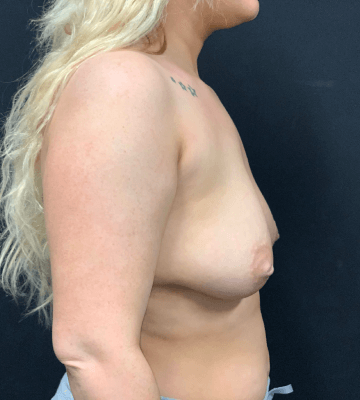Everything you need to know BEFORE breast augmentation
Our breast augmentation surgery in Charlotte gives you the opportunity to transform your breast size, shape, and volume. This specific procedure will use breast implants to increase the size of your breast and volume. There can be many reasons why you want to change the shape, size or “feel” of your breasts. And all of those reasons should be yours and yours alone! For many women breast size is part of feeling healthy, confident and attractive.
Breast Augmenation Surgery Options
As for your all of your surgery options, we’ll discuss everything with you during your breast augmentation consultation. Schedule your consult here. You have a few different options for breast implants, and this is a decision our plastic surgeon Dr. Andrew Gear will make with you. The size and type of breast implant you need will depend on a number of factors, such as the anatomy of your breast, the specific breast size increase you want, as well as your body type and skin elasticity. We have several resources available to help you evaluate and understand all the options you have with your breast augmentation in Charlotte. We understand you likely have questions, so don’t hesitate to give us a call for immediate help.
Are You A Good Candidate?
While many women are interested in breast augmentation, not every woman is a good candidate. With our Charlotte Plastic Surgery Center, our top priority is your safety and well-being. This is why we carefully screen all of our patients to ensure you’re a good fit for breast augmentation, which we’ll do in your one-on-one consultation with Dr. Andrew Gear.
Top 5 Things to know about Breast Augmenation
Pricing starts $6000
Implant options include USA made saline or silicone
Surgery is less than an hour long
Financing monthly payments as low as $211
Back to work in 5 days
Breast Augmenation FAQs
Implant pricing does not change with size. It does, however, change with the material chosen. Saline implants, for example, are cheaper than silicone implants due to fabrication costs. There are also some differences in the cost of specific types of silicone implant. Cohesive styles of silicone, such as the Mentor “Boost” are more expensive than the standard “gummy bear: silicone formulation.
No, they are not a lifetime device. Implant replacement is suggested every 10 years.
Breast augmentation is a plastic surgery procedure in which medical grade, “biocompatible” implants are inserted underneath the breast tissue. Breast implants are composed of a silicone shell and either a silicone or saline filling. Carefully selected for size, shape, and profile, breast implants expand the chest to create natural-looking curves.
Issues that can be corrected through breast augmentation include:
- Small size or “hypomastia”
- Breast deflation following pregnancy or weight loss
- Asymmetrical or uneven breasts
- Reconstruction after breast cancer treatment
- Changes in breast tissue due to aging
Women aged 18 and over who are in good general and emotional health are good candidates for breast augmentation. This procedure may be sought for several different reasons, all of which are equally valid. Candidates for breast augmentation may wish to address:
- Naturally small breasts
- Asymmetry, where one breast is noticeably larger than the other
- Changes to breast shape after pregnancy, breastfeeding, or weight loss
- Age-related deflation and sagging
- Physical defects caused by breast cancer treatment
Breast augmentation is a highly tailored process. There are many different implant types, and placement options from which to choose.
Saline Implants
Saline breast implants are composed of a silicone shell filled with sterile salt water that your body can safely process if a leak occurs. These implants give a uniform feel, shape, and firmness.
Silicone Implants
Silicone breast implants also employ a silicone shell but with a soft, silicone gel filling. They can provide a more natural feel, especially for women with little to no breast tissue. They are also less prone to rippling. Women who choose silicone implants will require radiologic imaging at 5 years to ensure integrity of the implant.
Gummy Bear Implants
The term “gummy bear” is a euphemism for the tear drop or shaped implants that result from using a more cohesive, thick silicone filling. A shaped implant can be useful for breast reconstruction and certain congenital anomalies, but as a rule they are firmer and less natural feeling and when they rotate, they look crazy and you will need another operation to fix them. I do not use them but have taken quite a few out in exchange for round implants.
Smooth vs. Textured Implants
In addition to the choice of filling, the implant can be textured or smooth. At one time, Textra devices were in vogue, but now they’re falling out of favor, due to their connection to higher levels of inflammation and ALCL, a rare type of lymphoma. Dr. Gear has never use textured devices in his career.
We only use implants made by Mentor which are proudly manufactured in the USA.
Dr. Gear’s consultation for plastic surgery is focused on getting to know the patient and their motivations behind breast enhancement. A brief medical history review and medical exam is conducted in addition to sizing exercises to better envision the desired outcome. Breast augmentation involves more than increasing the volume of the breasts to achieve a certain cup size. Despite being deceptively simple operation, it is very nuanced, and requires skill to choose the right device for the right breast to achieve a safe and natural outcome with minimal complications, long-term.
Breast augmentation surgery is performed in an accredited outpatient surgical center. Before entering the operating room, the surgical team reviews procedure details and answers any last-minute questions. In the operating room, the patient receives an intravenous general anesthesia (TIVA) that will cause a deep sleep state. After anesthesia has taken effect, a breathing tube is inserted into the throat to assist with breathing. This is removed before the patient wakes up after surgery.
The patient is comfortable and unaware of the procedural details as they are being performed. As discussed in the preoperative briefing, Dr. Gear makes incisions to accommodate the insertion of breast implants. The implants are placed in a pocket of tissue either above (subfascial) or beneath the muscle (subpectoral, dual plane). After both implants are in place, shape is observed for symmetry and size. Incisions are closed and the patient is moved to the recovery area for observation.
Patients can expect to feel sore after breast augmentation. A compression garment is applied after surgery to assist with swelling and discomfort. This may be worn for up to six weeks and should not be removed unless instructed by the surgical team. Sensations such as tightness and heaviness are common for the first 48 hours. Prescription medications are provided to alleviate pain. Most patients stop prescription medications within 4 to 5 days, after which over-the-counter medications are sufficient. Light activities may be resumed in a week to 10 days, with more strenuous activities and exercise resuming gradually over the ensuing weeks.
Breast augmentation carries inherent risks including infection, bleeding, changes in nipple sensation, implant displacement or “malposition”, and more long term complications such as capsular contracture. Dedicate surgical technique, proper choice of implant size, and inflammation and pain management significantly decrease these risks particularly capsular contracture which is the most common reason for surgical revisions. It is important to obtain care from a board-certified plastic surgeon with extensive experience using various breast implant devices. Dr. Gear values conservative cosmetics that complement a woman’s frame. The outcome of breast augmentation should be a natural-looking enhancement and improved femininity.















